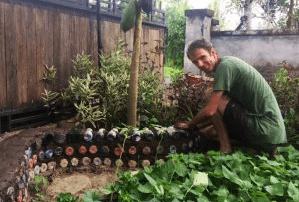Mandalas are an ancient and sacred art that can be found in cultures and religions around the world. In my experience, mandalas are one of the most powerful consciousness raising tools. A mandala can be as simple as a circle drawn in the sand, as beautiful as a cathedral rose window, or as sophisticated as a multi-terraced, kilometre wide temple like Borrobudar in Indonesia. Mandalas are an art form perfect for incorporating symbolism, colour-meaning, and numerology as meanings of all sorts can hang in the spaces between the radial geometrical symmetry of a mandala. Working with a blossoming circular mandalas unfold outwards from the centre, taking a flow of their own.
Making a mandala and tapping this outward flow is a potent process for exploring one’s subconscious, developing one’s intuition and revealing personality. Since Carl Jung first pointed to mandalas as a reflection of the collective unconsciousness, psychologists and therapists have used mandalas as potent introspective tools. I have used mandala making, both with individuals and groups as a way to mine personal and interpersonal insights. An individual’s mandala puts the once hidden, into the light.
This is just the tip of the iceberg however. We live in a civilizational moment of unmatched access to knowledge and information. However, our collective consciousness and wisdom have a long way to catch up. The consciousness raising properties of mandalas have vast import to our times of ecological, emotional and social ignorance. Add to this the power of uniting an indefinite amount of co-creators in mandalically designed collaboration, and we have one of the most potent tools for moving communities past problems.
In the Tibetan mandala making tradition, groups of monks would work in silence for days and weeks at a time to compose intricate mandalas from grains of coloured sand around a specific intention: perhaps blessing a new temple, asking for peace in a conflict, harmony in a community, etc. Without speaking, the monks would work together within the dynamic of the blossoming symmetry. In this way their collective intention and prayer for the space was made. The intense and focused process of making a mandala, of holding the specific intention, would deeply affect not only the mandala makers, but those observing the process. In so doing the collective consciousness of the surrounding community would be raised towards the focus of the intention.
In the same way, groups today can make similar co-creations. The very process is a profound experience of harmonious, intuitive collaboration. When groups of people make mandalas, the dynamics of personality and interpersonal interaction are likewise laid bare. This powerful dynamic raises both the consciousness of the participants and of the collective. When the group has a chance to process the experience afterwards, profound insights are inevitably mined.

Best of all, anyone can join the mandalas co-creation. By design, the mandala uses readily available materials, to be welcoming and inspiring, a new participant has but to grasp the unfolding geometry and begin their contribution to it.
I use these principles of mandalic co-creation to orchestrate movements with hundreds or thousands of people. In contrast to the compulsion of capital economy to pull people into participation, mandalic unfolding leverages much more profound and human motivations to inspire participation: belonging, community, beauty, harmony.
Although the mandala itself might not be visible, as long as the principles are there, before you know it dozens, then hundreds of people are contributing to a co-creative intention. There is no leader. The intention and vision lead the way– but of course morph organically (and appropriately) as the collaboration blossoms.
Our world stands to transcend compulsion once and for all. One day, when everything is being done for reasons of beauty, belonging, community and harmony, we’ll look back and shake our head at the old linear ways.
With joy I share mandala making far and wide.

